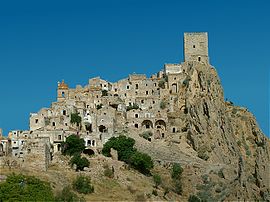Craco
| Craco | ||
|---|---|---|

|
|
|
| Country | Italy | |
| region | Basilicata | |
| province | Matera (MT) | |
| Coordinates | 40 ° 23 ' N , 16 ° 26' E | |
| height | 301 m slm | |
| surface | 76 km² | |
| Residents | 668 (Dec. 31, 2019) | |
| Population density | 9 inhabitants / km² | |
| Post Code | 75010 | |
| prefix | 0835 | |
| ISTAT number | 077007 | |
| Patron saint | S. Nicola Vescovo | |
 Old Craco |
||
Craco is an Italian commune in the province of Matera in the Basilicata region .
There are 668 residents in Craco (as of December 31, 2019). The place is 55 km south of Matera . The neighboring municipalities are Ferrandina , Montalbano Jonico , Pisticci , San Mauro Forte and Stigliano .
history
The regions of Basilicata far from the coast had been populated since the Iron Age. In the 8th century BC First Greek colonists landed on the Lucan coast.
Around 540 the area around Craco, which was inhabited by Greeks, was called Montedoro. Graves from the 8th century have been found here, which indicates the beginning of actual settlement. The name of the city first appears in 1060. Arnaldo, Archbishop of Tricarico, who was the owner of the land, called the area Graculum, which means “little plowed field”. From 1154 to 1168 the nobleman Eberto gained control of the settlement and created the first feudal dependencies. Eberto was probably of Norman origin. In 1179 Roberto di Pietrapertosa became the owner of the city.
In 1276 a university was founded in the city. The castle tower, which can be seen from afar, was also built by Muzio Attendolo Sforza during this period . Craco was an important military center under Frederick II , and in 1293 the castle tower became a prison. The population rose steadily from 450 (1277), 655 (1477), 1,718 (1532) to 2,590 inhabitants in 1561. Four large palazzi were built in the city by the 15th century: Palazzo Maronna, Palazzo Grossi, Palazzo Carbone and Palazzo Simonetti. With the establishment of the monastery of St. Pietro in 1630, a permanent monastic order was established. With the introduction of scientific cultivation methods, the monastery improved the income conditions of the population, who were mostly employed in agriculture, who mainly produced grain, olive oil, vegetables, wine and cotton. In 1656 a famine decimated the population by hundreds.
After the Neapolitan Republic was proclaimed in 1799, the city's residents eliminated the feudal system. Only a short time later, the city came under the control of the King of Naples-Sicily, followed by French occupation under Napoleon . On July 18, 1807, Craco was sacked by brigands . Most of the pro-French residents were killed in the process.
In 1815 the city was big enough to be divided into two districts: Vecchia, the highest area next to the castle and the castle tower; and the Quarter della Chiesa Madre, the area near the Church of San Nicola. After the unification of Italy, Craco was conquered by the brigands under their leader Carmine Crocco in 1861 . With the end of the Civil War, Craco was faced with environmental and geological problems. From 1892 to 1922, more than 1,300 Crachesi emigrated to North America, mainly because of the poor agricultural conditions.
Between 1959 and 1972 Craco was nearly destroyed by a series of landslides. In 1963 the city had to be evacuated. The landslides were likely caused by sewer and water works work. The new settlement “Craco Peschiera” was built for the residents in the valley to which the majority of the population was evacuated. After the earthquake in Irpinia in 1980 , the old town of Craco was abandoned.
In 2010 the World Monuments Fund added Craco to its list of endangered cultural monuments.
Today you can visit the old town on guided tours.
Culture
Film location
Several films have been shot in Craco including:
- 1979: Christ only came to Eboli by Francesco Rosi
- 1985: King David by Bruce Beresford
- 2004: The Passion of the Christ by Mel Gibson
- 2006: It came to pass at the time ... by Catherine Hardwicke
- 2008: Quantum of comfort from Marc Forster
music
The pianist Hauschka wrote the song "Craco" from the album Abandoned City (2014).
literature
- Azienda di promozione turistica - Basilicata, Matera e Provincia
Web links
- Craco in the World Monuments Fund
- https://www.italienundich.com/blog/2018/09/24/beruehmteste-geisterstadt-in-italien-craco-in-basilikata/
- https://de.linkfang.org/wiki/Craco (with more films than stated above)
Individual evidence
- ↑ Statistiche demografiche ISTAT. Monthly population statistics of the Istituto Nazionale di Statistica , as of December 31 of 2019.
- ↑ comune.craco.mt.it: 2010 World Monuments Watch ( En ) Retrieved December 15, 2013.
- ↑ a b c Craco Cinema (PDF; 1.9 MB) Accessed November 14, 2013.
- ↑ a b Imdb: Most Popular Titles With Location Matching "Craco, Matera, Basilicata, Italy" . Retrieved November 14, 2013.
- ^ Regioactive.de: Unconventional: Nils Frahm and Hauschka at the Jetztmusik Festival in Mannheim . Retrieved April 24, 2014.


